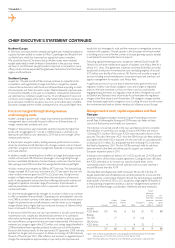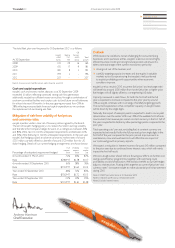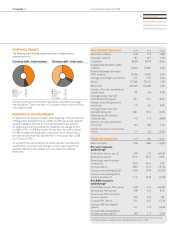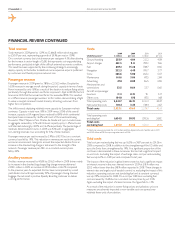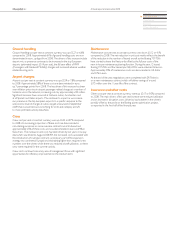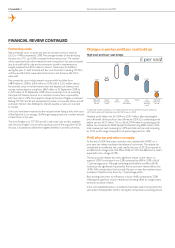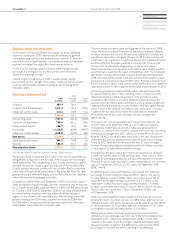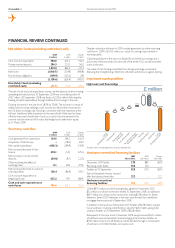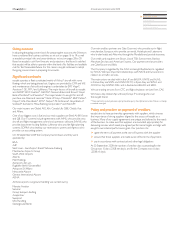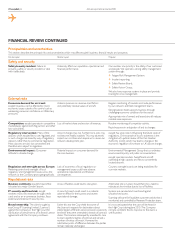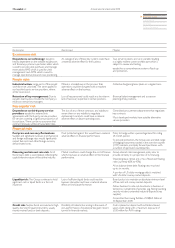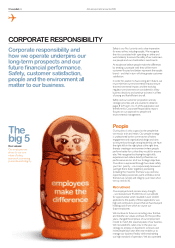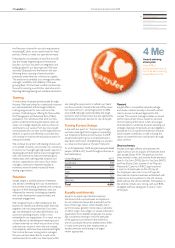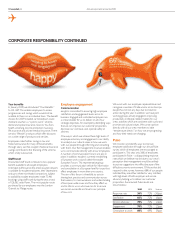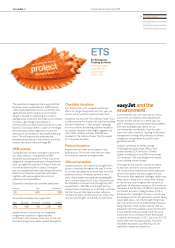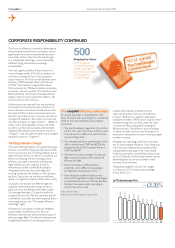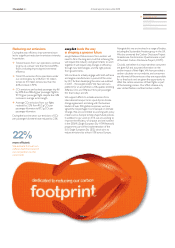EasyJet 2009 Annual Report Download - page 30
Download and view the complete annual report
Please find page 30 of the 2009 EasyJet annual report below. You can navigate through the pages in the report by either clicking on the pages listed below, or by using the keyword search tool below to find specific information within the annual report.
28 easyJet plc Annual report and accounts 2009
q
FINANCIAL REVIEW CONTINUED
Principal risks and uncertainties
This section describes the principal risks and uncertainties which may affect easyJet’s business, nancial results and prospects.
Risk description Potential impact Mitigation
Safety and security
Safety/security incident: Failure to
prevent a safety or security incident or deal
with it effectively.
Adversely affect our reputation, operational and
nancial performance.
Our number one priority is the safety of our customers
and people. We operate a strong safety management
system through:
Fatigue Risk Management System; q
Incident reporting; q
Safety Review Board; q
Safety Action Group; q
We also have response systems in place and provide
training for crisis management.
External risks
Economic demand for air travel:
easyJet’s business can be affected by macro
economic issues outside of its control such as
weakening consumer condence or inationary
pressures.
Adverse pressure on revenue, load factors
and potentially residual values of aircraft.
Regular monitoring of markets and route performance
by our network and eet management teams.
Strong balance sheet supports business through
challenging economic conditions for the sector.
Appropriate mix of owned and leased aircraft reduces
residual value exposure.
Competition: easyJet operates in competitive
marketplaces against both ag carriers and other
low-cost airlines.
Loss of market share and erosion of revenue. Routine monitoring of competitor activity.
Rapid response in anticipation of and to changes.
Regulatory intervention: Many of the
airports which easyJet ies to are regulated, and
as such, charges are levied by way of regulatory
decision rather than by commercial negotiation.
Many airports are also slot constrained and
therefore also subject to regulation.
Airport charges may rise. Furthermore, slots may
not become readily available. This may adversely
impact our cost base and require us to revise our
network development plan.
easyJet has a key role in inuencing the future state of
regulations. One example of its pro-activeness is the
instigation of a judicial review of the Civil Aviation
Authority (CAA) which may lead to changes in the
economic regulation of increases to UK airport charges.
Environmental impact: Consumer
attitude to climate change.
Potential impact on consumer demand for
the core business.
Environmental Management Group that co-ordinates
environmental policy and public communications.
easyJet operates modern, fuel-efcient aircraft
operating at high capacity and ies to conveniently
located airports.
Regulation and oversight across Europe:
Retaining control and oversight of local
regulatory and management issues across the
network as the Company grows geographically.
Lack of awareness of local regulations or
management issues could have adverse
operational, reputational and nancial
consequences.
Country oversight boards are being established for
our main markets.
Reputational risks
Business continuity: easyJet’s head ofce
is located at a major London airport.
A loss of facilities could lead to disruption. Alternative site is in place should there be a need to
relocate at short notice due to loss of facilities.
IT security and fraud risk: easyJet
receives most of its revenues through credit
cards and as an e-commerce business, faces
external and internal IT security risks.
A security breach could result in a material
adverse effect for the business and severe
reputational damage.
Systems are secured and monitored against
unauthorised access.
Scanning software for fraudulent customer activity that is
monitored and controlled by Revenue Protection team.
Brand ownership: The claim brought by
easyGroup IP Licensing Limited (‘Licensor’)
against the Company in the High Court for
clarication of certain terms of its Brand Licence
agreement with the Company continues.
Earlier this year the Court held that some of
the Licensor’s requests for declarations about
interpretation of Brand Licence provisions could only
be tried if they were amended to breach of contract
claims. The Licensor subsequently amended its case
to claim specic breaches of contract and served a
number of notices of breach. However, the
substantive points of difference between the parties
remain materially unchanged.
It is now anticipated that the case will be heard in
the High Court during June 2010. The Company
remains condent that its response to the claims is
well founded.


